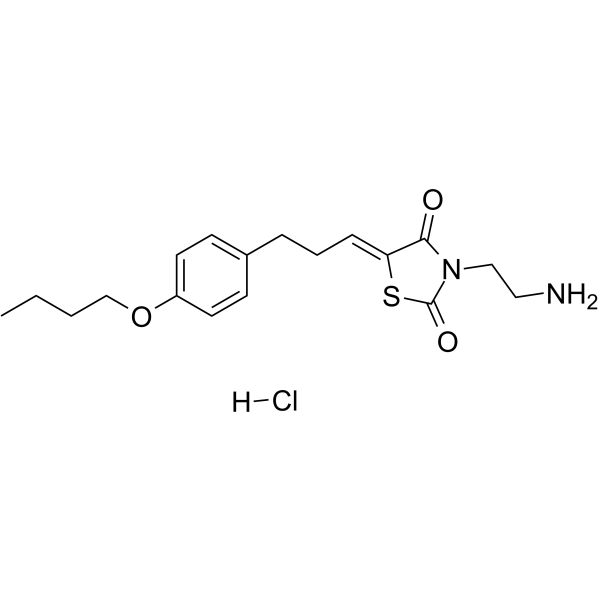
K145 hydrochloride
CAS No. 1449240-68-9
K145 hydrochloride( —— )
Catalog No. M29603 CAS No. 1449240-68-9
K145 hydrochloride is a selective sphk2 inhibitor with substrate competitiveness and oral activity, with IC50 of 4.3 μM and Ki of 6.4 μM. K145 hydrochloride can induce apoptosis and has strong antitumor activity.
Purity : >98% (HPLC)
 COA
COA
 Datasheet
Datasheet
 HNMR
HNMR
 HPLC
HPLC
 MSDS
MSDS
 Handing Instructions
Handing Instructions
| Size | Price / USD | Stock | Quantity |
| 5MG | 45 | In Stock |


|
| 10MG | 61 | In Stock |


|
| 25MG | 87 | In Stock |


|
| 50MG | 122 | In Stock |


|
| 100MG | Get Quote | In Stock |


|
| 200MG | Get Quote | In Stock |


|
| 500MG | Get Quote | In Stock |


|
| 1G | Get Quote | In Stock |


|
Biological Information
-
Product NameK145 hydrochloride
-
NoteResearch use only, not for human use.
-
Brief DescriptionK145 hydrochloride is a selective sphk2 inhibitor with substrate competitiveness and oral activity, with IC50 of 4.3 μM and Ki of 6.4 μM. K145 hydrochloride can induce apoptosis and has strong antitumor activity.
-
DescriptionK145 hydrochloride is a selective sphk2 inhibitor with substrate competitiveness and oral activity, with IC50 of 4.3 μM and Ki of 6.4 μM. K145 hydrochloride can induce apoptosis and has strong antitumor activity.(In Vitro):K145 hydrochloride inhibited the activity of SphK2 in a dose-dependent manner with an IC50 of 4.30 μM. The Lineweaver-Burk analysis revealed a Ki of 6.4±0.7 μM for SphK2 and indicated that K145 hydrochloride is a substrate competitive inhibitor (with sphingosine). K145 hydrochloride accumulates in U937 cells, suppresses the S1P level, and inhibits SphK2. K145 hydrochloride also exhibited inhibitory effects on the growth of U937 cells as well as apoptotic effects in U937 cells, and that these effects may be through the inhibition of downstream ERK and Akt signaling pathways.(In Vivo):In BALB/c-nu mice injected with U937 cells, K145 hydrochloride (50 mg/kg; oral gavage; for 15 days) treatment significantly inhibited the growth of U937 tumors at 50 mg/kg dose and no apparent toxicity was observed.
-
In VitroK145 (0-10 μM; 24-72 hours; U937 cells) treatment significantly inhibits the growth of U937 cells in a concentration-dependent manner.K145 (10 μM; 24 hours; U937 cells) treatment significantly induces apoptosis in U937 cells.K145 (4-8 μM; 3 hours; U937 cells) treatment decreases the phosphorylation of ERK and Akt.Treatment with K145 (10 μM) causes a decrease of total cellular S1P without significant effects on ceramide levels. Cell Viability Assay Cell Line:U937 cells Concentration:0 μM, 4 μM, 6 μM, 8 μM, 10 μM Incubation Time:24 hours, 48 hours, 72 hours Result:Significantly inhibited the growth of U937 cells in a concentration-dependent manner.Apoptosis Analysis Cell Line:U937 cells Concentration:10 μM Incubation Time:24 hours Result:Significantly induced apoptosis in U937 cells.Western Blot Analysis Cell Line:U937 cells Concentration:4 μM, 8 μM Incubation Time:3 hours Result:Phosphorylated ERK and Akt were decreased.
-
In VivoK145 (50 mg/kg; oral gavage; daily; for 15 days; BALB/c-nu mice) treatment significantly inhibits the growth of U937 tumors in nude mice. Animal Model:BALB/c-nu mice injected with U937 cells Dosage:50 mg/kg Administration:Oral gavage; daily; for 15 days Result:Inhibited the growth of U937 tumors at 50 mg/kg dose and no apparent toxicity was observed.
-
Synonyms——
-
PathwayApoptosis
-
TargetApoptosis
-
RecptorApoptosis
-
Research Area——
-
Indication——
Chemical Information
-
CAS Number1449240-68-9
-
Formula Weight384.92
-
Molecular FormulaC18H25ClN2O3S
-
Purity>98% (HPLC)
-
SolubilityIn Vitro:?H2O : 126.7 mg/mL (329.16 mM)
-
SMILESCl.CCCCOc1ccc(CC\C=C2/SC(=O)N(CCN)C2=O)cc1
-
Chemical Name——
Shipping & Storage Information
-
Storage(-20℃)
-
ShippingWith Ice Pack
-
Stability≥ 2 years
Reference
molnova catalog



related products
-
CWI1-2
CWI1-2 is a potent IGF2BP2 inhibitor that inhibits its interaction with M6A-modified target transcripts by binding IGF2BP2. CWI1-2 has anti-leukemic activity and can induce apoptosis and differentiation.
-
PCC0208017
PCC0208017 is an inhibitor of MARK3 and MARK4 with IC50s of 1.8 and 2.01 nM. PCC0208017 disrupts microtubule dynamics and displays potent antitumor activity.
-
SPOP-IN-6lc
SPOP-IN-6lc is a potent SPOP inhibitor with multiple roles in cancer, oncostatic in a variety of tumors, but functions as an oncogene in renal cancer.SPOP-IN-6lc can be used to study cell signaling and apoptosis.



 Cart
Cart
 sales@molnova.com
sales@molnova.com


